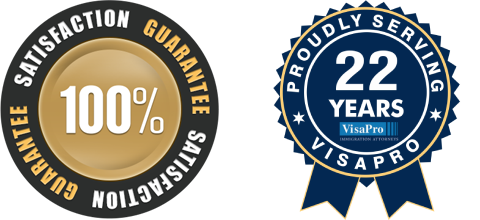Introduction
People often confuse the terms “work visa” and “work permit”. In order for a foreign national to work in the U.S., one or the other is required.
But which one do you need? Let’s take a closer look at these terms and see which one is right for you.
1. Work Visa For USA
The US issues different types of visas that relate to the principal purpose of a foreign national’s trip to the US. A temporary US work visa allows an individual to enter the US to take up employment as opposed to, for example, a US visitor visa, which is issued for the purpose of visiting the US.
A temporary US work visa can be defined as an endorsement by immigration authorities giving the applicant permission to enter the US in order to work. It denotes that a foreign national has applied, been examined, and approved for the visa being sought.
A foreign national who seeks to enter the US on a work visa must obtain a US visa stamp from a U.S. Embassy or Consulate, which is placed on the applicant’s passport. The US visa allows the foreign national to travel to a US port of entry, airport or land border crossing and request permission to enter the US. While the US visa does not guarantee entry to the US, it does indicate that a consular officer at a US Embassy or Consulate abroad has determined that the foreign is eligible to seek entry into the US for a specific purpose.
Hence, the US work visa allows you to seek entry into the US in order to work.
DID YOU KNOW?
Most US work visas require that a US employer file a petition with US Citizenship & Immigration Services. The petition must be approved before applying for the work visas.
2. Types Of US Work Visas
There are many types of US work visa, each suited for a specific purpose of travel and/or nature of employment. The most common types are:
- H-1B Visa for Specialty Occupations workers
- H-1B1 Visa for Specialty Occupations workers from Chile or Singapore
- H-2A Visa for Temporary Agricultural workers
- H-2B Visa for Temporary Non-agricultural workers
- E-1 Visa for Treaty Traders
- E-2 Visa for Treaty Investors
- E-3 Visa for Specialty Occupation workers from Australia
- TN Visa for NAFTA professional workers from Canada and Mexico
- P Visa for Athletes, Artists, Entertainers
- Visa for Extraordinary Artists, Teachers, Scientists and Businesspersons
- J visa for Exchange Visitors
- R Visa for Religious workers
3. Work Permit For USA
The Work Permit (or “Employment Authorization Document”) is a card issued by U.S. Citizenship & Immigration Services authorizing the foreign national holder of the card to work in the U.S. The employment authorization document or EAD is commonly referred to as the “work permit.”
The US work permit allows foreign nationals to work in the U.S. for any employer, generally without restriction. Obtaining a work permit from USCIS denotes that the foreign national is in the U.S. in a status that makes him or her eligible for the work permit.
In order to obtain the work permit, the eligible foreign national must file the Form I-765 with USCIS while present in the U.S.

4. Who Is Eligible For A Work Permit?
US immigration law is very specific about who can be issued an EAD or work permit. Those eligible for a US work permit include, but are not limited to:
- F-1 students seeking Optional Practical Training or who have been offered off-campus employment under the sponsorship of a qualifying international organization, or seeking off-campus employment due to severe economic hardship
- E-1/E-2 Dependent Spouse of an E-1/E-2 Treaty Trader or Investor
- L-2 Spouse of an L-1 Intra-Company Transferee
- H-4 Spouse of an H-1B Specialty Occupation worker (in certain circumstances)
- J-2 Spouse or minor child of a J-1 Exchange Visitor
- Adjustment of Status applicant
- Eligible Dependents of Employees of Diplomatic Missions, International Organizations, or NATO
- B-1 nonimmigrant domestic servant of a nonimmigrant employer
- B-1 nonimmigrant domestic servant of a U.S. citizen
- Persons in or applying for temporary protected status
- Asylees/Refugees and their spouses and children
DID YOU KNOW?
Those who enter the U.S. with a work visa or obtain work visa status in the U.S. are authorized to work incident to their status. That means they are authorized to work because they hold the particular work visa status and do not need a separate EAD or work permit. Those who require a work permit must wait until they obtain the Employment Authorization Document in order to start working.
Let’s look at some real-world examples to see whether a work visa or work permit is required:
- John was born in Tulsa, Oklahoma. Since he is a US citizen he does not need work authorization to work in the U.S.
- Bill is a national of the United Kingdom. He entered the US on an L-1A work visa to head up the finance department of a subsidiary of the company that he works for in the UK. His L-1 visa is a work visa that allows him to work for a specific employer. He only needs to provide his visa and I-94 showing his entry in L-1A status to start work for the U.S. Company.
- Susan is here with her husband Pierre. Pierre is the executive chef at an exclusive French restaurant that is owned by the company that he has worked for since 1987. Pierre entered the US on an E-2 visa since his company invested a substantial amount of money to get the restaurant up and running. Susan is getting bored at home and wants to start working. She was an accountant in France before she and Pierre moved to the US. Susan’s visa does not allow her to just start working in the US. However, as an E-2 dependent spouse of an E-2 employee, she is eligible for a work permit. She will have to apply for and receive the Employment Authorization Document (EAD) before she can work.
- Fred is in the US is F-2 status (his wife is enrolled in a University and is studying software engineer). Unfortunately for Fred, the F-2 spouse of an F-1 visa holder cannot get a work permit. He will not be able to work in the US unless he can qualify for a work visa of his own.
5. Who Does Not Need A Work Visa or Work Permit (EAD) To Work In The US?
US citizens and Lawful Permanent Residents do not need any type of “work permit” or “work visa” to work in the U.S. US citizens have the right to work anywhere in the U.S. and for anyone. Lawful permanent residents (and conditional residents) also have the right to work anywhere in the U.S. and for anyone (except in jobs that are open only to US citizens). The “Green Card” is proof of their right to live and work permanently in the U.S.
6. How Do I Apply For Employment Authorization Document (EAD)?
Employment Authorization Document (Work Permit) is applied for by using USCIS Form I-765, Application for Employment Authorization. The application is submitted, together with supporting documentation, to the office with jurisdiction over the category that you qualify for. This could include one of the USCIS Service Centers, the National Benefits Center, or in some cases with the US State Department (who will then forward the application to the USCIS).
Conclusion
Though a US work visa and US work permit appear to be leading to the same goal of employment in US, they differ in many distinct ways.
As much as you may wish to work in the U.S., however, you must be eligible under one of specific categories that allows you to work during the authorized stay in the US. In some of these categories, your work visa will give you the authorization to work as soon as you enter the U.S. For other categories, you will need to obtain the work permit (or Employment Authorization Document) before you can commence employment.
Our experienced immigration lawyers are happy to assist you in determining your eligibility for a US work visa or a work permit, and help you obtain permission to work in the U.S. Schedule A Free Consultation Today >>
What VisaPro Customers Are Saying
[VisaPro legal team] was incredibly knowledgable and extremely helpful throughout the process. We were exceptionally impressed with how they have combined the great personal and communication skills they bring and also technology with a highly intuitive website which guides you and keeps you updated throughout the process……..This is a true testimonial, I would highly recommend VisaPro to anyone looking for guidance and success in this area."
 Paul Lyons, President, Atlas Intelligence Inc
Paul Lyons, President, Atlas Intelligence Inc